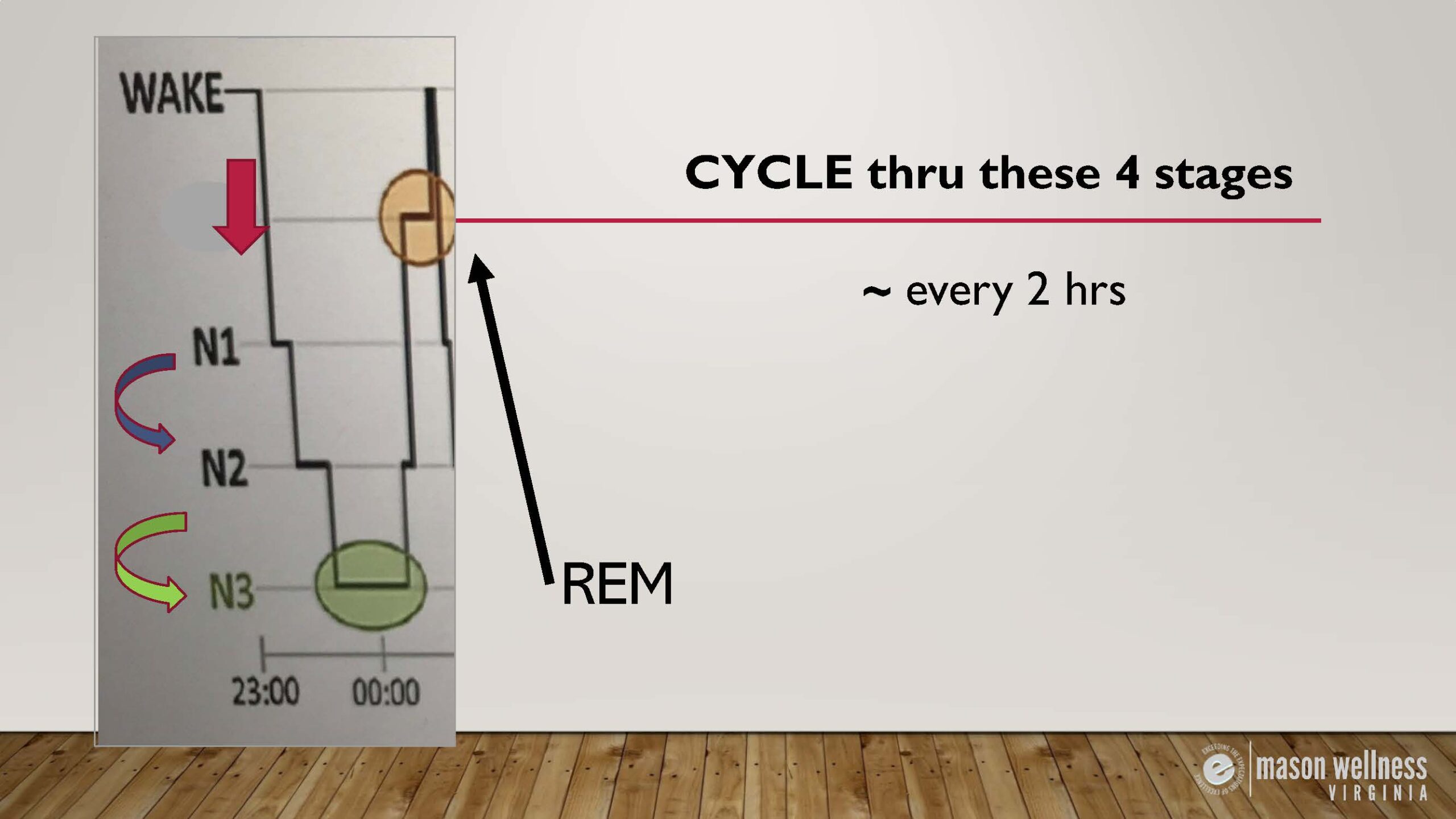
20 Jan A Conversation with Dr. Erika Mason on the Four Stages of Sleep
Hi, I’m Dr. Erika Mason, and we’re going to talk about the four different stages of sleep. I guess sometimes people think that we just sleep, but no, we have four different stages that we cycle through, and we cycle through them every two hours, 90 to 120 minutes. And so the four cycles of sleep are N1, N2, N3, and then the REM, rapid eye movement, which is the dreaming type of stage of sleep.
When we first go to sleep, we’re kind of dozing, and that’s going into N1. I call it the twilight, because at twilight, you’re aware of your surroundings. Maybe you’ve experienced this when you’re sitting in a meeting in the afternoon and you’re dozing, or at church, listening to the preacher. So you can hear your surroundings, you’re aware of them, but your brain is wanting to doze and your eyelids are heavy. But if we put an EEG on your brain, it would show that these slow wave patterns that shows that you are actually asleep. So if you think about drowsy driving, or when you’re driving and you’re dozing, you are actually asleep, and that’s kind of scary.
So after our eyelids close, we go right into the second stage of sleep, which is N2. And it’s kind of boring sleep. Our body’s just resting. There might be a little bit of memory consolidation, or short term going into long term memory, but it’s really our body just resting.
And then we should go into N3 sleep, which is the deepest sleep. If we compare when a child is born up to the time that a child is a teenager or even into college, the majority of their night’s sleep is N3, that deepest sleep. That’s why you can pick up a toddler that might have fallen asleep in the car or on the sofa, pick them up, carry them upstairs, and they never wake up. They’re kind of like a heavy wet rag or a rag doll. And so they’re in that deepest sleep. And the majority of their sleep, like 60 to 70% between birth and adulthood, is N3 sleep for them.
Well, luckily we don’t need to grow and develop, so our N3 sleep is only 15 to 20% of our night. But going back to a child, they’re growing and developing, they’re putting into memory what they learned at school that day. When they get into puberty, that’s when their hormones are being secreted. They also are getting growth hormones so that they grow. So N3 sleep for them is really important. That’s why children need to sleep 10, 12, longer hours than what us as adults do.
So for adults, our N3 sleep is so important, but a lot of times, if we have different sleep problems, like insomnia or obstructive sleep apnea, it will wake us up and we will go from N3 to the lighter sleep, N2 or even N1, but never get back into N3. So we can survive without N3, but really, N3, I call it the bomb. It’s so wonderful that we get into the N3 sleep.
So in N3, quite a few things happen. One is that our body heals and repairs. Two, our brain puts stuff from short term memory into long term memory. And it also kind of, I think about all these drawers being pulled out, and it’s organizing our memory and thoughts in those drawers, or organizing it in our brain. The other thing is that that’s where testosterone, and for women, progesterone, estrogen, estradiol, all those different hormones are secreted. So for men, if they get bumped out of N3 sleep, they might end up having low testosterone, which also could then exhibit in erectile dysfunction. For women, we might have some difficulty or go into similar things like we’re going through menopause. So our hormones are pretty important, and that’s where they’re secreted, is in N3.
And then we also have two neurotransmitters that are secreted in our brain, which are drugs, which are fabulous drugs to have on board. We’re so lucky that our body secretes them and makes them. One is dopamine and one is serotonin. And those are the pleasure drugs. That means that the glass is half full, or that’s also where if patients have some pain, it gives them a little bit of a buffer so that they don’t feel their pain as bad. It’s also when our body heals and repairs. So it’s an amazing stage of sleep that we can do without, but we’re so much better if we get into it and have those N3 stages throughout the night.
The one other thing which I think is fascinating is we have these star shaped cells in our brain called glial cells. And when you get into N3, they start expanding and contracting, and expanding and contracting in your brain. And by that movement, it starts moving our cerebral spinal fluid in our brain and actually washes our brain. Isn’t that amazing? Like, we get brainwashed every night. So how cool is that? It just takes a different meaning to brainwashing. So that washing of our brain actually is removing the toxins that are in our brain, as well as now we have learned that people that have dementia and Alzheimer’s might have a buildup of a protein called amyloids. And so that protein buildup is not being washed away. And so those glial cells are a big proponent in having that washing away of our toxins and those protein buildup. So N3 is really pretty cool, and it’s pretty important.
And then we go into our REM, or our dreaming stage. And that is a pretty cool stage, too. We cannot survive without dreaming. Now, not everybody remembers their dream, but what you might do is not wake up after your first stage of a dream. It might be 10 minutes and then you’ll fall right back into N2 or N3 stage of sleep and cycle back through. So the first dream that you have could be 10 minutes, and then two hours later it could be 17 minutes. And then two hours later, it could be like 30 minutes. And then maybe even 45 minutes, right before you wake up. And that’s why when you wake up out of a dream first thing in the morning, that’s the longest dream, but it is also the dream that you might remember. But you might not remember the ones earlier in the night. But our body cannot survive without dreaming.
But what’s unusual is that our body, so that we don’t act out our dream, actually paralyzes itself so that we don’t hurt ourself. Like, if we are running through a field and jumping over a brook, we wouldn’t jump out of bed and hurt ourself. So by paralyzing our body, that causes our diaphragm to be the only thing that’s breathing. If we’re sitting here now, we’re breathing through our pectoralis muscles, our intercostal muscles, which are in between our rib cage, and even some of our neck muscles, to inhale and exhale. But when we’re dreaming, we’re breathing only with our diaphragm, kind of like being on a ventilator. And so that diaphragm breathing is really a little bit more difficult sometimes if we have an obstruction of our airway, or if we’re laying on our back and gravity’s going against us, and things like that, which also can cause some problems if you have obstructive sleep apnea.
So I think that’s pretty much the gist of the four stages of sleep. They’re amazing. And we really should be getting seven to eight hours of sleep because that’s kind of what we need to do. The American way is, oh, we’ll sleep when we’re dead. Unfortunately, adding another shift to manufacturing so that we could make more money, that’s not really the way that our life should be. If you think about people over in Europe or down in South America, they take time, smell the roses, enjoy their time eating. They may might take a siesta in the afternoon. Things are about quality of life. And I think America has really kind of forgotten that it’s not all about the money but enjoying life. When you have your health and you have good sleep, then you can be prosperous as well.

